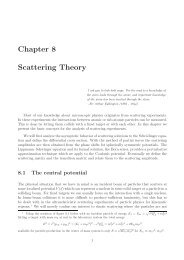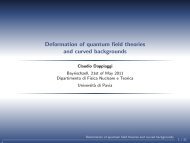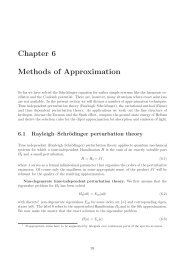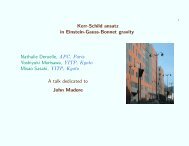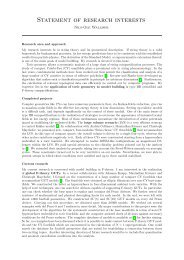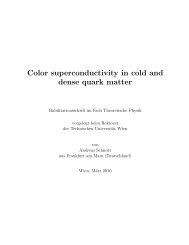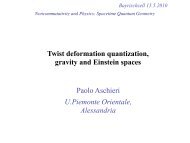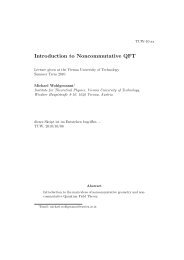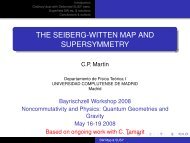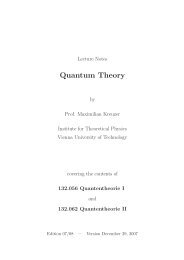Chapter 8 Scattering Theory - Particle Physics Group
Chapter 8 Scattering Theory - Particle Physics Group
Chapter 8 Scattering Theory - Particle Physics Group
You also want an ePaper? Increase the reach of your titles
YUMPU automatically turns print PDFs into web optimized ePapers that Google loves.
CHAPTER 8. SCATTERING THEORY 156<br />
follows by Fourier transformation and regularization with a small imaginary part of the energy.<br />
More explicitly, the matrix elements of the operator (E − H 0 ± iε) −1 in position space are<br />
∫<br />
1<br />
1<br />
〈x|<br />
E − H 0 ± iε |x′ 〉 = 〈x| d 3 K|K〉〈K|x ′ 〉 (8.148)<br />
E − H 0 ± iε<br />
∫<br />
= d 3 1<br />
K 〈x|<br />
2<br />
2m (k2 − K 2 ) ± iε |K〉 e−i K⃗x ⃗ ′<br />
(8.149)<br />
(2π) 3/2<br />
= 2m<br />
2 ∫ d 3 K<br />
(2π) 3 e i ⃗ K(⃗x−⃗x ′ )<br />
k 2 − K 2 ± iε = 2m<br />
2 G± 0 (⃗x − ⃗x ′ ). (8.150)<br />
With z = E ± iε this is proportional to the resolvent R z (H 0 ) = (H 0 − z) −1 of H 0 , which is a<br />
bounded operator for ε > 0. The Lippmann–Schwinger equation can now be written as<br />
|u ± 〉 = |u 0 〉 +<br />
1<br />
E − H 0 ± iε V |u ±〉 (8.151)<br />
where |u + 〉 corresponds to the scattering solution with retarded boundary conditions.<br />
Wave operator and transition matrix. The Born series for the solutions of (8.151) is<br />
|u ± 〉 = |u 0 〉 +<br />
∞∑ 1<br />
(<br />
E − H 0 ± iε V )n |u 0 〉 (8.152)<br />
In order to sum up the geometric operator series we use the matrix formula<br />
n=1<br />
1 + 1 A V + ( 1 A V )2 + ... = (1 − 1 A V )−1 = ( 1 A (A − V ))−1 = (A − V ) −1 A<br />
= 1<br />
A−V (A − V + V ) = 1 + 1<br />
A−V V (8.153)<br />
for A = E − H 0 ± iε. Since A − V = E − H ± iε with H = H 0 + V the Born series can thus<br />
be summed up in terms of the resolvent of the full Hamiltonian<br />
|u ± 〉 = |u 0 〉 +<br />
where we introduced the wave operator or M/oller operator<br />
1<br />
E − H ± iε V |u 0〉 = Ω ± |u 0 〉, (8.154)<br />
Ω ± = 1 +<br />
1<br />
E − H ± iε V (8.155)<br />
which maps plane waves |u 0 〉 to exact stationary scattering solution |u 0 〉 → |u ± 〉 = Ω ± |u 0 〉. If<br />
we insert this representation for the scattering solution into the formula (8.120) we need to be<br />
careful about the normalization of the wave function. In the present section we prefer to work<br />
with momentum eigenstates normalized as 〈 ⃗ k ′ | ⃗ k〉 = δ 3 ( ⃗ k ′ − ⃗ k) which yield a factor (2π) 3 as<br />
compared to the plane waves e ±ikx with normalized amplitude |φ k (x)| = 1. We hence obtain<br />
f = −2π 2 〈 ⃗ k ′ |U|u + 〉 = −4π 2 m 2 〈⃗ k ′ |V Ω + |k〉 (8.156)<br />
for the scattering amplitude, which suggests to define the transition operator T as<br />
T := V Ω + = V (1 +<br />
1<br />
E−H+iε V ) = (1 + V 1<br />
E−H+iε )V = Ω† −V (8.157)




